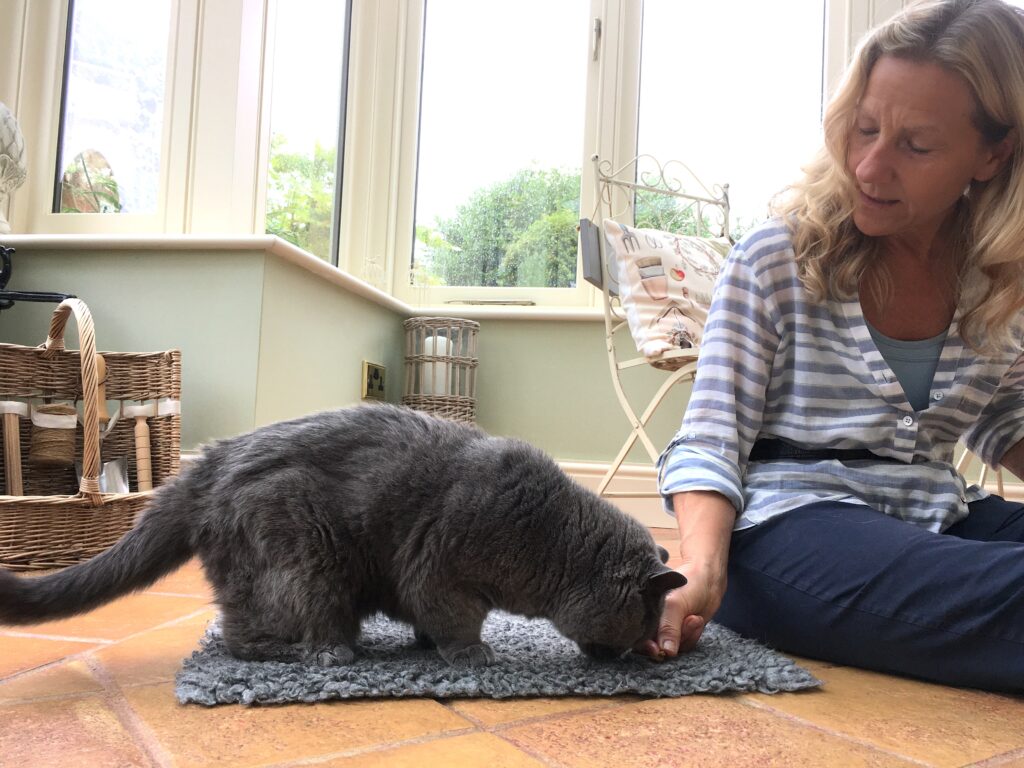Comfort Mat Training: Helping a Cat Relax and Reduce Anxiety

Having a specific mat (or blanket) to relax and chill out on is really useful for all cats but especially so for those that are fearful and anxious. Relaxation is fundamental to desensitisation and counterconditioning training and, once a cat is trained, just seeing and resting on it can induce feelings of relaxation which can offset stress and anxiety. To enhance the mat as a place to relax, it can be sprayed with calming herbal aromas (ensuring they have been tried and tested on the cat) or synthetic FFP.
This training is to induce relaxation. Therefore, for the cat that gets highly excited when food appears, a nice gentle stroke around the face or grooming in their preferred places might be better. However, if this isn’t enough to motivate them it is possible to intersperse tactile rewards with food rewards.
The Benefits
A comfort mat can be extremely useful for:
- Helping cats stay calm whilst undergoing DS and CC training.
- Inducing calmness during situational events such as fireworks and thunderstorms.
- Mitigating stress for trips outside the home (vets, cattery etc.).
- Providing comfort for cats that feel anxious when left home alone.
- Acting as a station for carrying out husbandry and medication at home.
Stages of Training
Stage One: Paws on the Mat
- Select a specific mat or blanket that the cat particularly likes to relax on. Make sure it can be folded so it can fit in their cat carrier.
- Choose a time that the cat is already relaxed and showing signs of contentment. After they have had some physical exercise can be a good time.
- Place the chosen blanket/mat in front of you and close to the cat.
- As the cat advances towards it, give a quiet verbal marker (‘Yes’ or ‘Good’ or click if you’re using clicker training) and reward them with a tasty treat.
- Place the treat a little way from the mat so they have to move away from the mat and work out that it is coming towards the mat that gets them the reward.
- Continue the process, rewarding each movement to the mat.
- Once they are getting the hang of it – wait until they place a paw on the mat and mark and reward that behaviour.
- The idea is to shape their behaviour, gradually progressing to them placing all four paws on the mat.
- For cats that have difficulty in progressing, luring can be used. However, do wait a little while as often an animal learns better if they work things out for themselves.
- Once they begin to have all four paws on the mat, increase the time they stay on the mat slightly before delivering the reward.
Stage Two: Building Duration
- To build duration in to the training, wait a little longer before giving the marker and reward. Start with a fraction of a second, very gradually increasing the time they stay on the mat.
- If they voluntarily begin to settle themselves, they can be given a really tasty treat on the mat – followed by a gentle and loving stroke around the face.
Stage Three: Shaping Relaxation
Shaping involves rewarding small incremental steps towards the desired goal. As we want to shape relaxation, the training has to be done when the cat is in that emotional state. Training them when they are alert and behaviourally aroused won’t be effective.
- Once a cat is moving onto a mat consistently, and staying on it for a longer period, it’s time to shape and reward them for relaxing on it.
- To help them adopt a relaxed body posture luring can be useful. To do this place a treat in your hand and place it in front of their chin moving it away from them along the mat so they are encouraged to lie down.
- Other signs of relaxation can be rewarded too, such as slow blinking and relaxed body postures.
- Food might be a bit too arousing as a reward for this part of the training, so use a gentle stroking or grooming with the occasional treat, but only if necessary.
- Patience may be required before the signs of greater relaxation are achieved. Sitting quietly close by whilst reading a book, listening to music and relaxing yourself (with your eyes peripherally on the cat) will help you to be able to reward them as they relax further.
- Outside of training, ‘capture’ the behaviour with a gentle stroke whenever they voluntarily go on the mat and relax. We really want them to know that going on the mat and chilling out on it is a great thing to do.
- Over time, with this kind of pairing, the cat will soon recognise the mat as being a place to relax and feel calm.
Adapted from information in The Trainable Cat by John Bradshaw and Sarah Ellis.
- Bradshaw, John (Author)
- English (Publication Language)
- 352 Pages – 03/30/2017 (Publication Date) – Penguin (Publisher)
I may receive commission when you click Amazon links on this page and make a purchase. However, this does not impact my recommendations, reviews or comparisons.
